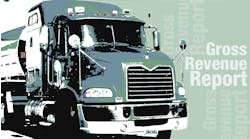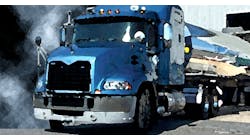Latest from Gross Revenue Reports
Gross Revenue Report: Tank Fleets Struggle to Survive as Economy Teeters on Recession
Too much equipment, higher operating costs, and not enough loads. That pretty well sums up the experience of many tank truck carriers over the past year. The 2000 Bulk Transporter Gross Revenue Report paints a picture of an industry that worked hard just to survive.
Tank truck carriers didn't suffer alone, though. Just about every sector of the trucking industry was hurt by an economy that teetered on the edge of recession through the second half of the year. One indicator of the difficulties faced by the trucking industry as a whole: a record level of bankruptcies.
A shortage of freight topped the list of problems faced by tank truck carriers. Shipments of industrial chemicals were essentially flat through most of the year. Drops in automobile production and new home construction cut demand for paints and coatings by about 2%. Specialty chemicals demand slumped in the second half of the year.
Adding to the problems caused by the decline in freight were higher costs for insurance and diesel. One tank fleet manager pointed out that the only positive note for the year was that with so much equipment parked the driver shortage wasn’t as much of an issue.
Despite the difficulties, the tank truck industry was able to eke out 4.6% revenue growth, roughly the same level as in 1999 but below the cost of borrowing money. Profitability was sacrificed by many companies. Seventy-five percent of the companies that participated in the Bulk Transporter Gross Revenue Report posted higher revenues, but almost 60% reported that their operating ratios worsened. Even the top 10 tank truck carriers had a difficult year.
Trimac Transportation System Ltd reclaimed the top spot after a three-year absence. Quality Distribution Inc and Matlack Systems Inc were two and three respectively. Rounding out the top ten were Superior Bulk Logistics Inc, Kenan Transport Co, Bulkmatic Transport Co, Schneider National Bulk Carriers, Dewey Corporation, Groendyke Transport Inc, and A&R Transport Inc.
The ranks of the 100 Club (tank truck carriers with revenues above $100 million) increased. New additions were A&R Transport, which grew to $111.3 million from $85.1 million, and Liquid Transport, which jumped to $104.1 million from $98.6 million.
With revenues of $2.4 billion, the 10 largest carriers accounted for 43.3% of the revenues in this report. A year earlier, the top 10 tank truck carriers had combined gross revenues of $2.2 billion and accounted for 42% of the revenue total.
The top 25 carriers had $3.5 billion in revenues, or 64.3% of the total represented in this report. This was slightly higher (.3%) than in the 1999 report. The 50 largest carriers had revenues of $4.5 billion, or almost 82%, which was virtually unchanged from 1999. Of the 129 carriers in this report, three-fourths reported higher revenues in 2000 than in 1999. A year earlier, two-thirds had revenues that were higher than the previous year. About 30% were able to improve operating ratios in 2000, compared with 21.2% in 1999.
Total 2000 revenues for all carriers in this report were $5,558,834,256.63. In 1999, those same carriers reported a combined total of $4,947,286,493.40.
For the 129 carriers in this report, the average revenue for 2000 was $43,091,738, up from $41,227,387 in 1999. Excluding the top 10 carriers from the total revenues produces an average revenue of $24,207,680. The median carrier on the list, the one with an equal number of carriers above and below it, had revenues of $19,565,741. In 1999, the median carrier revenue was $19,135,200.
Operating ratios for 2000 and 1999 were supplied for 106 of the carriers in this report. Thirty-one showed improvement over the previous year, six more than in last year's Gross Revenue Report. The operating ratio represents operating expenses as a percentage of revenue. What is of greatest concern is the number of ratios above 95%. Seventy-six carriers had operating ratios between 95.0% and 99.9%, four more than in 1999. The number of carriers with 100% ratios increased by two in 2000 to nine. Thirty fleets had ratios between 90.0% and 94.9%, four less than the previous year. Eight had operating ratios below 90%, the same as in 1999.
A majority of the carriers in the report supplied tractor revenues, which give an indication of productivity levels. The average for 2000 was $142,130. That was an increase from the 1999 tractor revenue average of $127,461. All of the carriers in the top 10 reported tractor revenues, and the average for this group was $160,054, up over 8% from the 1999 Gross Revenue Report.
The highest revenue per tractor ($367,709) was reported by a mid-sized East Coast chemical hauler. The lowest amount ($39,125) came from a small Midwest petroleum transporter.
Eleven carriers that emphasize chemical hauling had an average revenue per tractor of $154,699, well above the average for all of the carriers in this year’s report, but lower than the average for chemical carriers last year. The average for chemical carriers in 1999 was $158,040. Revenues ranged from the high of $367,709 to a low of $68,160. Average revenue per tractor for eight petroleum transporters was $162,867, significantly higher than the previous year, when the same number of carriers reported $124,761 for an average. The high for 2000 was $240,285, while the low was $97,556.
Eight dry bulk carriers posted average tractor revenues of $136,172, a big improvement over the $115,186 average achieved in 1999. Tractor revenues ranged from $102,670 to $210,420.
Five liquid and dry bulk food fleets recorded average tractor revenues of $132,077, a boost from the $122,956 average in 1999. The high for the category was $171,607, and the low was $108,860.
Many of the figures here are from preaudited reports, and some may include nonbulk revenues or revenues from subsidiary tank truck carriers. In most cases, the figures were supplied directly to Bulk Transporter. The magazine greatly appreciates the cooperation of all who helped in the preparation of this report.
To view a chart with this year's ranking and revenues, use the "Related" link below to find it and all reports going back to 2001 in the Gross Revenue Reports Archive.









